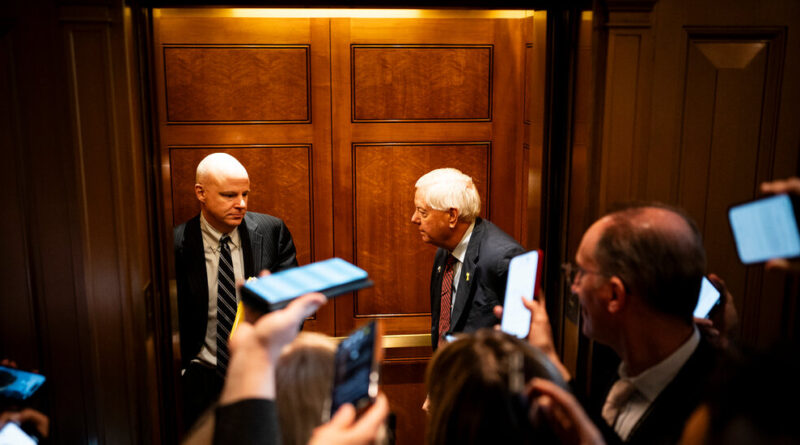Senate G.O.P. Passes Budget Resolution, and Punts on Tough Questions
The budget plan that Republicans pushed through the Senate early Friday was a necessary first step toward enacting President Trump’s ambitious domestic goals, but it punted the most difficult and divisive questions about how Congress will do so.
On a largely party-line vote, 52-48, Senate Republicans won adoption of a blueprint that calls for a $150 billion increase in military spending and $175 billion more for border security over the next decade.
How will they pay for it? That’s a question for another day. What about the huge tax cuts they and Mr. Trump have promised? We’ll figure that out later, senators say.
Over in the House, Republicans have been agonizing to come up with at least $2 trillion in spending cuts to pay for Mr. Trump’s fiscal agenda and placate their most conservative members. Their plan, which G.O.P. leaders hope to put to a vote as early as next week, loads vast tax cuts and policy changes into one huge package and calls for slashing government programs deeply to finance it all. But it faces a perilous road through the closely divided House, where Republicans hold a razor-thin majority.
Republicans in the Senate have essentially delayed any decision on those thorny details, focusing instead on delivering an early win to Mr. Trump in the form of money for his hard-line anti-immigration agenda. They said they would address questions of spending and tax cuts later in a separate bill.
“We’ve decided to front-end load security,” said Senator Lindsey Graham of South Carolina, the chairman of the Budget Committee. “We want to make the tax cuts permanent. We’re going to work with our House colleagues to do that. They expire at the end of the year, but we have time to do that. It is the view of the Republican Senate that when it comes to border security, we need not fail. We should have the money now to keep that momentum going.”
It is a strategy that has involved the Senate leapfrogging the House in an attempt to fast-track a political victory for Mr. Trump. But it also leaves unresolved some of the trickiest issues that could make or break Republicans’ push to enact a sweeping fiscal plan over the objections of Democrats.
Mr. Graham has said that his plan would be paid for through a mix of new revenue from domestic drilling and unspecified spending cuts.
“We’re going to make sure it’s paid for by taking money away from other parts of the government that are less worthy,” Mr. Graham said at a news conference this month. He added that he was directing four Senate committees to come up with “at least” $1 billion in cuts each that would help offset the cost of the bill in four years.
The Senate’s two-bill strategy also defers tough decisions on which taxes to cut. Just extending the tax cuts enacted in 2017 is estimated to cost $4 trillion. Many of the measures Mr. Trump campaigned on, including eliminating taxes on tips and Social Security benefits, are even more costly.
Senate Republicans have said they will figure out the fine print later in the year and are focused now on urgently funding Mr. Trump’s enforcement operations at the southern border.
“President Trump’s actions are working — they are working so well that the Trump administration says it is running out of money for deportations,” said Senator John Barrasso of Wyoming, the No. 2 Republican. “Senate Republicans will act quickly to get the administration the resources they requested and need.”
But their strategy is also a tacit acknowledgment of the treacherous path their party’s tax and spending package faces in the House. Senate leaders chose to plow ahead with their budget plan even after Mr. Trump endorsed the House’s one-big-bill approach on Wednesday, characterizing their measure as a fail-safe should the House falter.
“If the House can produce one big, beautiful bill, we’re prepared to work with them to get that across the finish line,” Senator John Thune of South Dakota, the majority leader, said at a news conference on Wednesday. “But we believe that the president also likes optionality.”
The House’s budget plan lays out in greater detail where Republicans plan to find spending cuts. For example, the plan instructs the Energy and Commerce Committee, which oversees Medicaid, to come up with at least $880 billion in cuts — more than half of the reductions laid out in the budget outline.
But even that plan does not lay out exactly which federal programs they will cut — or by how much. Lawmakers are required to do so only after the House and Senate adopt their budget resolutions and write legislation detailing specific policy changes to meet the targets they have set.
Even without those details, some Republicans are already feeling antsy about the spending cuts they may be asked to approve. A group of House Republicans in the Congressional Hispanic Caucus warned in a letter to G.O.P. leaders that their party needed to “ensure that assistance programs” like food stamps “remain protected as nearly 22 percent of Hispanic families rely on this critical program as a temporary safety net during difficult times.”
“I don’t like the idea of massive Medicaid cuts,” Senator Josh Hawley of Missouri told HuffPost. “We should have no Medicare cuts of any kind.”

